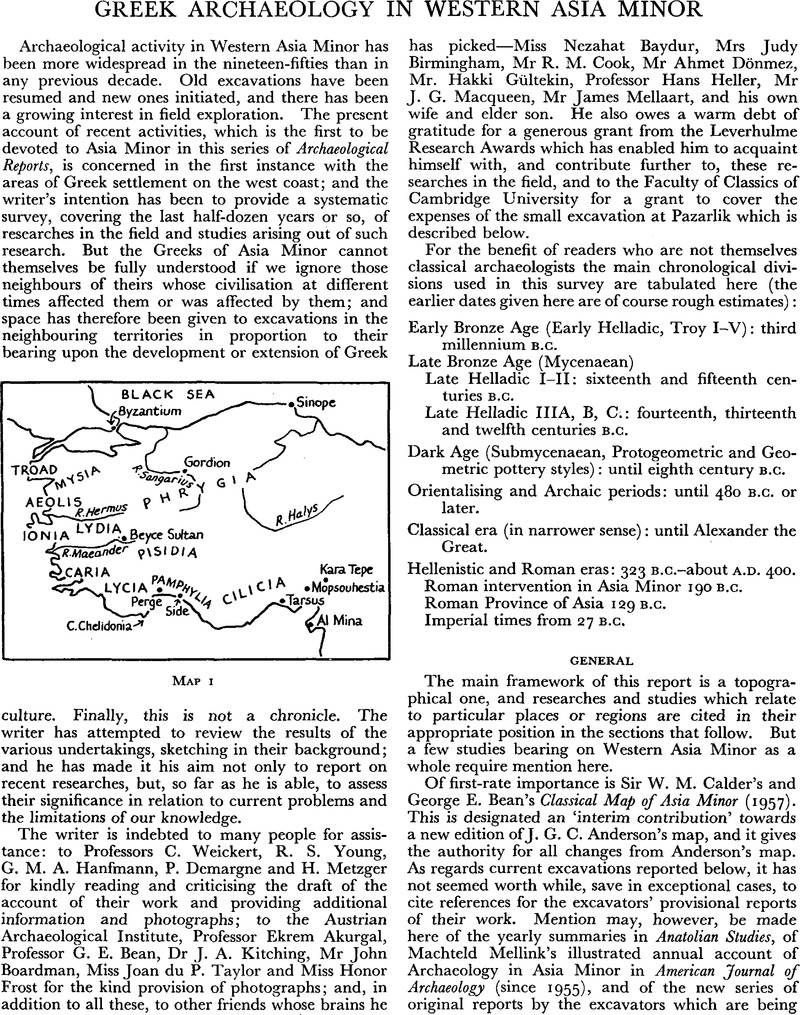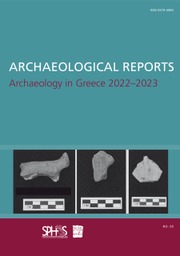Article contents
Greek Archaeology in Western Asia Minor
Published online by Cambridge University Press: 03 October 2012
Abstract

- Type
- Brief Report
- Information
- Copyright
- Copyright © Authors, the Society for the Promotion of Hellenic Studies and the British School at Athens 1959
References
1 Études d'Archéologie classique i (1958) 119 ff.Google Scholar
2 Antiquaries Journal 1959 170 ff.Google Scholar
3 Anatolia ii (1957) 123 ff.Google Scholar
4 Bellinger has published a study of the first civic tetradrachms of Ilion, as also of late bronze issues of Alexandria Troas, in American Numismatic Society, Museum Notes viii (1958) 9 ff.
5 See his article in AJA 1958 9 ff.
6 BCH ixxx 53 ff., 632.
7 Amer. Num. Soc. Centenn. Publ. 593 f.
8 Neue Beiträge Zur Klass. 8 Neue Beitrage zur klass. Altertumswissenschaft 71 ff. (cf. JHS Ixxvi 123); Études d'Archéologie classique i (1958) 121 ff. (where, however, Martin makes Koldewey's intermediate members go with the volute-pieces, and so in the cella at Neandria (as opposed to Larisa and Thasos) would apparently have the ‘Blattkranz’ members serving as complete capitals).
9 The German survey, Driehaus, J., Istanbuler Mitteilungen vii 76 ff.Google Scholar
10 Nachrichten Akad. Gött. 1956 283 ff.
11 BSA liii-liv 20 n. 47, with a note on the coinages of Larisa and ‘Boeone’.
12 Hellenica x (1955) 178 ff.
13 Die Astynomeninschrift von Pergamon (Berlin Academy 1954).
14 Rev. Phil. 1957 66 ff.
15 Num. Chron. 1954 I ff.
16 Archaeology 1958 129. For Lysimachia see also L. Robert, Hellenica x (1955) 266 ff.
17 Amer. Num. Soc. Centenn. Publ. (1958) 603 ff. For inscriptions of Parion (which the Roberts are studying) and lists of deputations of Parion at Claros see L. Robert, Hellenica x (1955) 271 ff.
18 Hellenica x (1955) 128 ff., 296.
19 Akurgal in Anatolia i (1956) pl. 10.
20 Vorläufiger Bericht über die Ausgrabungen in Sinope (1956). For the stelae see Akurgal, III Berl. Winckelmannsprogramm; on the dating of the earliest finds see Boysal, Y., Türk Arkeoloji Dergisi viii. 2, 30 ff.Google ScholarSee also Budde, L., Türk Ark. Dergisi vi. 2, 5 ff.Google Scholar
21 Fuller accounts of the discoveries are being published annually in AJA.
22 Anatolia iii (1958) 145 ff.Google Scholar
23 Bulleten xix (1955) 115 ff.Google Scholar
24 Amer. Num. Soc. Centenn. Publ. 585 f.
25 Historia 1958 259 ff.Google Scholar
26 Num. Chron. xviii (1958) 187 ff. For the hoards seeGoogle ScholarXoe, S. P., ‘Two Hoards of Persian Sigloi’, Num. Notes no. 136 (1956).Google Scholar
27 Charles (1957) 27 ff.Google Scholar
28 Anz. Akad. Wien 1956 219 ff.; some other inscriptions are published, with topographical comment, byGoogle ScholarRobert, L., Anatolia iii 108 ff.Google Scholar
29 See BSA liii–liv 20 n. 46.
30 Cf. Keil, OJH xiii Beibl. 11 no. 2.
31 BSA liii–liv 21.
32 BCH lxxxiii (1959) 513 ff.
33 Oikonomos Memorial Volume II, Arch. Eph. 1953-1954 149 ff.
34 Jahrbuch für Kleinas. Forschung iii. 43 ff.
35 REG lxxii p. xiii f.
36 Amer. Num. Soc. Centenn. Publ. (1958) 586 ff.Google Scholar
37 OJH xi Beibl. 135 ff. (for the Kuşadasi site, 145 ff.).
38 For these items see below, pp. 50
39 JdI Ixix 101 ff.; AM lxxi 145 ff.
40 Rev. Phil. 1957 7 ff.Google Scholar
41 BSA lii 106 ff.
42 Rev. Phil. 1958 54 ff.Google Scholar
43 Milás (1954) 137.Google Scholar
44 Rev. Phil. 1957 9. In supposing that Pidasa lay in the valley Robert was no doubt misled by his theory that Ioniapolis was at Kazikli; since Ioniapolis and Heracleia had a common boundary, the eastern flanks of Grion must on that assumption have belonged to one or both of them, and there would therefore have been no place for Pidasa in the mountain here. But Robert's theory about Ioniapolis is now abandoned; and the ancient evidence for Pidassa in fact fits much better with a site in the mountain.
44a A new study of these problems is Huxley's, G. L.Achaeans and Hittites (1960)Google Scholar.
45 At Ahirköy, Anat. Stud, vii 112.
46 REG lxxii 171 f.
47 BSA l 95 169 ff. pl. 12 a–b.
48 REA lxi 65 ff.
49 JdI lxix 1 ff. A work by K. Jeppesen (Paradeigmata, Jutland Arch. Soc. Publ. iv 1958) discusses the Mausoleum and other fourth-century buildings.
50 REG lxxi 313.
51 For Theangela see BSA l 113 ff., 145 ff.; lii 89 ff. (with a plan of the site). Robert, J. and , L., REG lxxi 315.Google Scholar An important document for independent Theangela is the late Hellenistic round cippus of a Theangelan in Athens which Kirchner dated to the first century B.C. In castigating Kirchner's negligence L. Robert (in Hellenica ii 75) claims that the inscription may go back to the third century; but a glance at the stone itself would have shown him that such a dating is completely out of the question.
52 Akarca, A. ve T., Milâs (1954); an identification of the site of Kildara is also proposed.Google Scholar
53 Milâs pls. 29–35 (the foundation pls. 30 right, 31 below); for Peçin see also P. Wittek, Das Fürstentum Mentesche passim.
54 BSA lii 138 ff.
55 Jeppesen, K., Labraunda, Swedish Excavations and Researches i 1.Google Scholar
56 References for these researches can be found in BSA lii 142 f.
57 L'urbanisme dans la Grèce antique 147 ff.
58 Amer. Num. Soc. Centenn. Publ. 582 ff.
59 Ill. Land. News, 25.4.1959 712 f.
60 Jahrbuch für Kleinas. Forschung iii 52 f.
61 Mélanges Isid. Lévy (1955) 553 ff.Google Scholar
62 Medet Höyük, Anat. Stud, iv 192, 203; Belleten xix (1955) 129, 133, 136.
63 See BSA lii 85 ff. for references for these items.
64 Charites (1957) 23 ff.
65 REG lxviii 267.
66 The history of the name Gelibolu (Gallipoli) here is uncertain; but to the references already known to scholars (cf. BSA lii 83 f.) may be added the Turkish portolan of Piri Re'is of A.D. 1521, in which the name Gelibolucuk (‘Little G.’) is given to the islet (Bekçi I.) at the entrance to the bay of what is now called Gelibolu.
67 JHS lxxiii 10 ff., lxxiv 85 ff.
68 H. Möbius, on the other hand, now argues that it is the old dynast's wife (Θɛωρíα (1960) 159 ff.).
69 Anz. Akad. Wien 1958 nr. 2.
70 BSA li 136 ff.
71 Hellenka x (1955) 188 ff.Google Scholar
72 These investigations are being published in Anat. Stud. ix and x.
73 JHS lxxviii 57 ff.
74 The buildings of the Agora region at Side, together with the inscriptions and sculptures found there, are published by Mansel, , Bean, and Inan, J. in Die Agora von Side und die benachbarten Bauten (1956).Google Scholar
75 Mansel, , Anatolia iii (1958) 1 ff. pls. 2–4.Google Scholar
76 Anat. Stud. iv 134 f.
- 5
- Cited by


